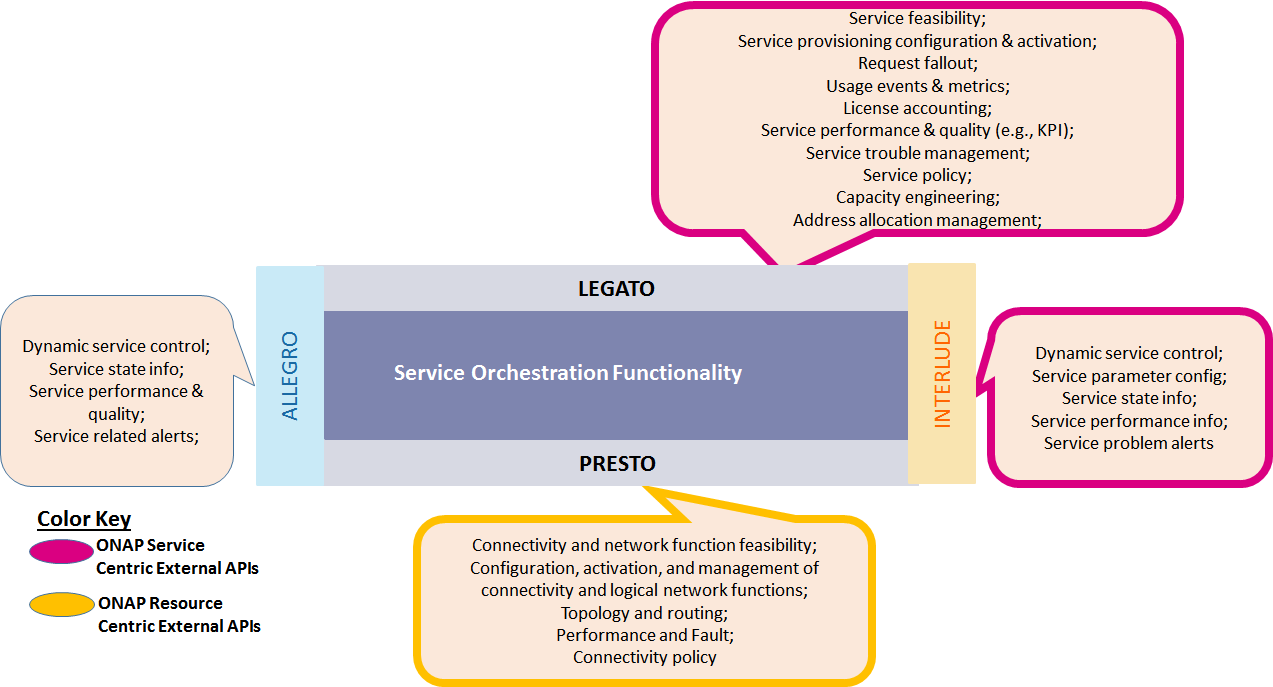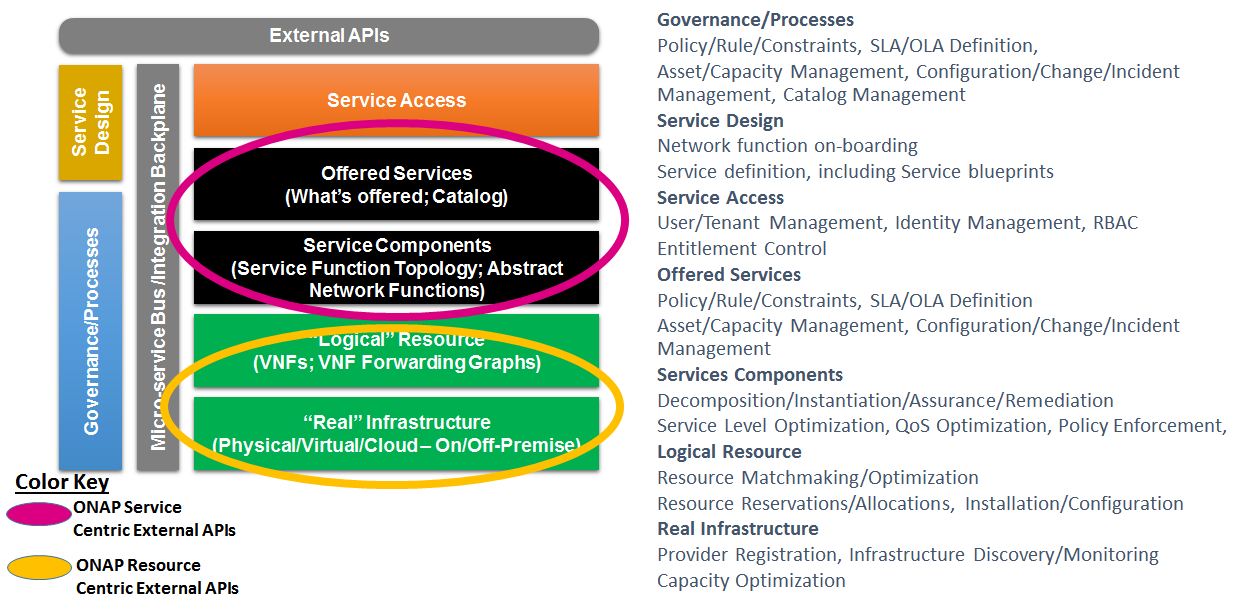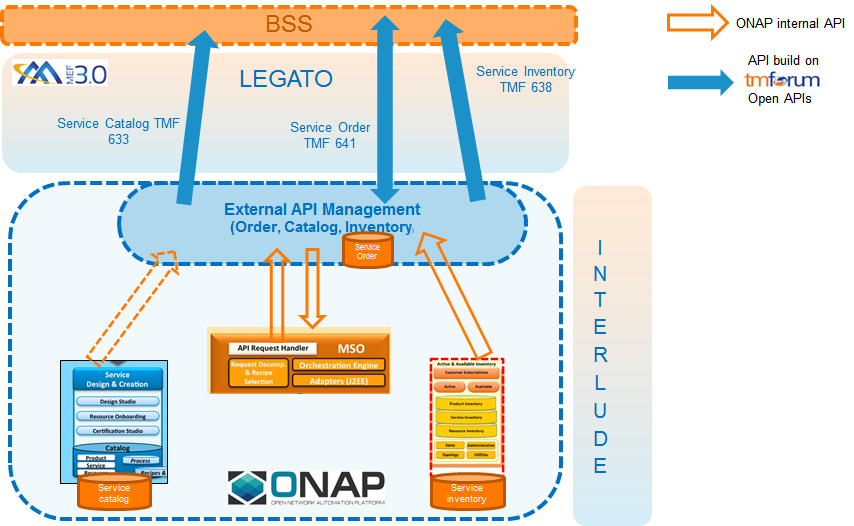It is envisioned that from a Service Provider to Partner Provider interaction context (i.e. MEF Interlude), the ONAP External API will support the following types of interacts:
•Service Provider controls aspects of the Service within the Partner domain (on behalf of the Customer) by requesting changes to dynamic parameters as permitted by service policies.
•Service Provider queries state of the Service.
•Service Provider requests change to administrative state or permitted attributes of a Service.
•Service Provider request creation of connectivity between two Service Interfaces as permitted by established business arrangement.
•Service Provider request instantiation of functional service components as permitted by established business arrangement.
•Service Provider queries the Partner for detailed information related to Services provided by the Partner to the Service Provider.
•Service Provider receives Service specific event notifications (e.g., Service Problem Alerts) from the Partner.
•Service Provider receives Service specific performance information from the Partner.
•Service Provider request Service related test initiation and receive test results from the Partner.
DRAFT PROPOSAL FOR COMMENTS
...
| Project Name | VNFRQTS |
|---|---|
| Target Release Name | Beijing, Casablanca, Dublin |
| Project Lifecycle State | Incubation; Refer to ONAP Charter, section 3.3 Project Lifecycle for further information |
| Participating Company | AT&T, CenturyLink, China Mobile, China Telecom, Orange, PCCW Global, Verizon, Amdocs, Ciena, Huawei, Intel, Netcracker, ZTE, MEF |
...
Provide a clear and unambiguous ONAP service abstraction so that the BSS/OSS can exchange service requirements and service capabilities in a common and consistent fashion.
Provide a way to rapidly integrate new Services and Service Components into ONAP so that they can quickly introduce capabilities for their customers and within their infrastructure.
Enable management the entire lifecycle of Services within ONAP in a common way so that they can ensure orchestration, manageability and control of each Service in an easily integrateable and low cost way.
Model Driven approach: a cohesive way to have a shared view of information across ONAP external interfaces that can be used for or be input into a model driven process whereby the cost of delivering platform functionality is drastically reduced and the time to delivery is dramatically decreased.
Release Deliverables
Indicate the outcome (Executable, Source Code, Library, API description, Tool, Documentation, Release Note...) of this release.
It is envisioned that from a Service Provider to BSS/OSS interaction context (i.e. MEF Legato), the ONAP External API will support the following types of interacts:
- BSS/OSS retrieves Service Models
- BSS/OSS requests service feasibility determination.
- BSS/OSS requests reservations of capabilities related to a potential Service.
- BSS/OSS requests activation of Service.
- BSS/OSS receives Service activation tracking status updates.
- BSS/OSS retrieves Service Inventory
- BSS/OSS receives usage events due to a Customer initiating dynamic activity on their Service (e.g., increase in bandwidth).
- BSS/OSS receives a summary of Service quality and usage information.
- BSS/OSS receives Service state and fault event information
- BSS/OSS receives Service Activation Testing results.
- BSS/OSS receive capability information about the Service layer.
- BSS/OSS manages Licenses
- BSS/OSS receives License Usage information
It is envisioned that from a Service Provider to Partner Provider interaction context (i.e. MEF Interlude), the ONAP External API will support the following types of interacts:
- Service Provider controls aspects of the Service within the Partner domain (on behalf of the Customer) by requesting changes to dynamic parameters as permitted by service policies.
- Service Provider queries state of the Service.
- Service Provider requests change to administrative state or permitted attributes of a Service.
- Service Provider request creation of connectivity between two Service Interfaces as permitted by established business arrangement.
- Service Provider request instantiation of functional service components as permitted by established business arrangement.
- Service Provider queries the Partner for detailed information related to Services provided by the Partner to the Service Provider.
- Service Provider receives Service specific event notifications (e.g., Service Problem Alerts) from the Partner.
- Service Provider receives Service specific performance information from the Partner.
- Service Provider request Service related test initiation and receive test results from the Partner.
Release Deliverables
| Deliverable Name | Deliverable Description |
|---|---|
| Documentation | Documentation of User Stories; Use Cases and Interactions (e.g., UML); Information Models (e.g., UML); Data Models (e.g., JSON); Interface Profiles and Functional Definition;ONAP Component Mapping and Functional Analysis |
| External API | JSON Swagger / OpenAPI for the External Interface |
| External API Agent Software | Code contribution for External API Agent functionality |
| Deliverable Name | Deliverable Description |
| To fill out | To fill out
Sub-Components
List all sub-components part of this release.
Activities related to sub-component must be in sync with the overall release.
Sub-components are repositories are consolidate in a single centralized place. Edit the Release Components name for your project in the centralized page.
- External API Agent
- Service Catalog API
- Service Ordering API
- Service Inventory API
ONAP Dependencies
List the other ONAP projects your depends on.
Dependent on APIs from SDC, SO, and AAI
Architecture
High level architecture diagram
...
Anyone reading this section should have a good understanding of all the interacting modules.
API Incoming Dependencies
List the API this release is expecting from other releases.
Prior to Release Planning review, Team Leads must agreed on the date by which the API will be fully defined. The API Delivery date must not be later than the release API Freeze date.
Prior to the delivery date, it is a good practice to organize an API review with the API consumers.
...
Platform Maturity
Refering to CII Badging Security Program and Platform Maturity Requirements, fill out the table below by indicating the actual level , the targeted level for the current release and the evidences on how you plan to achieve the targeted level.
Area | Actual Level | Targeted Level for current Release | How, Evidences | Comments |
|---|---|---|---|---|
| Performance | 0 | 0 |
| |
| Stability | 0 | 0 |
| |
| Resiliency | 0 | 0 |
| |
| Security | 0 | 1 |
| |
| Scalability | 0 | 0 |
| |
| Manageability | 0 | 0 |
| |
| Usability | 0 | 0 |
|
API Incoming Dependencies
List the API this release is expecting from other releases.
Prior to Release Planning review, Team Leads must agreed on the date by which the API will be fully defined. The API Delivery date must not be later than the release API Freeze date.
Prior to the delivery date, it is a good practice to organize an API review with the API consumers.
| API Name | API Description | API Definition Date | API Delivery date | API Definition link (i.e.swagger) |
|---|---|---|---|---|
| SDC: Catalog API | Exposes Service Catalog | TBD | TBD | https://wiki.onap.org/display/DW/SDC+API |
| SO: Service Instantiation API | Requests for Service Instantiation | TBD | TBD | |
| AAI: Service Inventory API | Query for Service Inventory | TBD | TBD |
API Outgoing Dependencies
API this release is delivering to other releases.
| API Name | API Description | API Definition Date | API Delivery date | API Definition link (i.e.swagger) | To fill out | High level description of the API | Date for which the API is reviewed and agreed | To fill out | Link toward the detailed API description
|---|---|---|---|---|---|---|---|---|
| ExtAPI: Service Catalog | External Service Catalog API | TBD | TBD | TBD | ||||
| ExtAPI: Service Ordering | External Service Ordering API | TBD | TBD | TBD | ||||
| ExtAPI: Service Inventory | External Service Inventory API | TBD | TBD | TBD |
Third Party Products Dependencies
Third Party Products mean products that are mandatory to provide services for your components. Development of new functionality in third party product may or not be expected.
List the Third Party Products (OpenStack, ODL, RabbitMQ, ElasticSearch,Crystal Reports, ...).
| Name | Description | Version | |||
|---|---|---|---|---|---|
| TBD | TBD | TBD | To fill out | To fill out | To fill out |
In case there are specific dependencies (Centos 7 vs Ubuntu 16. Etc.) list them as well.
...
Describe the plan to integrate and test the release deliverables within the overall ONAP system.
Confirm that resources have been allocated to perform such activities.
Potential Test Cases for External API include:
- BSS/OSS retrieves Service Models
- BSS/OSS requests activation of Service.
- BSS/OSS receives Service activation tracking status updates.
- BSS/OSS retrieves Service Inventory
Gaps
This section is used to document a limitation on a functionality or platform support. We are currently aware of this limitation and it will be delivered in a future Release.
List identified release gaps (if any), and its impact.
| Gaps identified | Impact | ||
|---|---|---|---|
| TBD | TBD | To fill out | To fill out |
Known Defects and Issues
Provide a link toward the list of all known project bugs.
...
| Risk identified | Mitigation Plan | Contingency Plan | |||
|---|---|---|---|---|---|
| TBD | TBD | TBD | To fill out | To fill out | To fill out |
Resources
Fill out the Resources Committed to the Release centralized page.
...
It is not expected to have a detailed project plan.
| Date | Project | Deliverable | |||
|---|---|---|---|---|---|
| TBD | TBD | TBD | To fill out | To fill out | To fill out |
Documentation, Training
- Highlight the team contributions to the specific document related to he project (Config guide, installation guide...).
- Highlight the team contributions to the overall Release Documentation and training asset
- High level list of documentation, training and tutorials necessary to understand the release capabilities, configuration and operation.
- Documentation includes items such as:
- Installation instructions
- Configuration instructions
- Developer guide
- End User guide
- Admin guide
- ...
...


